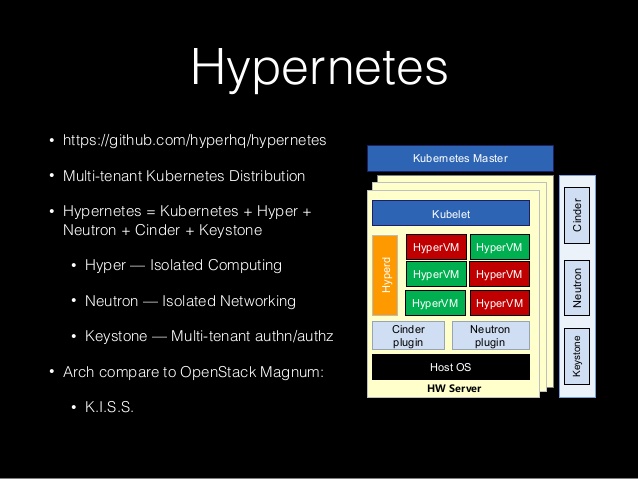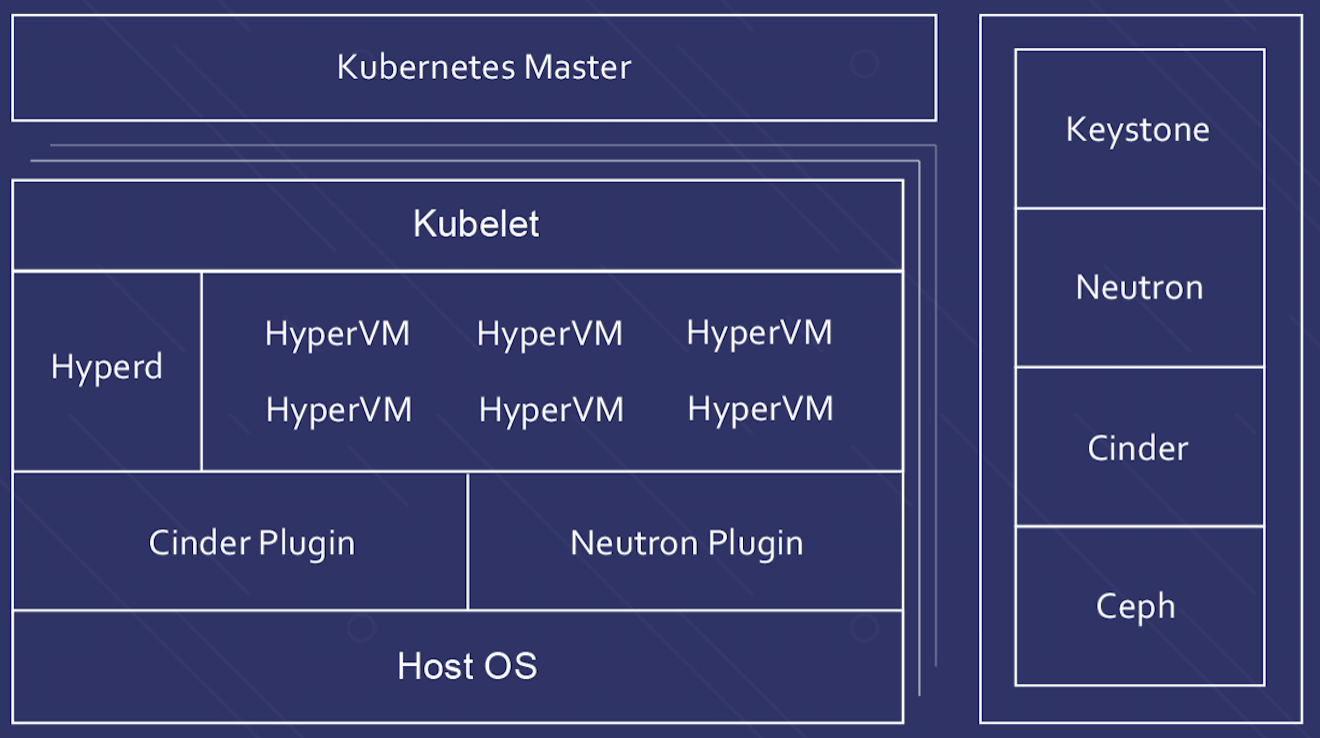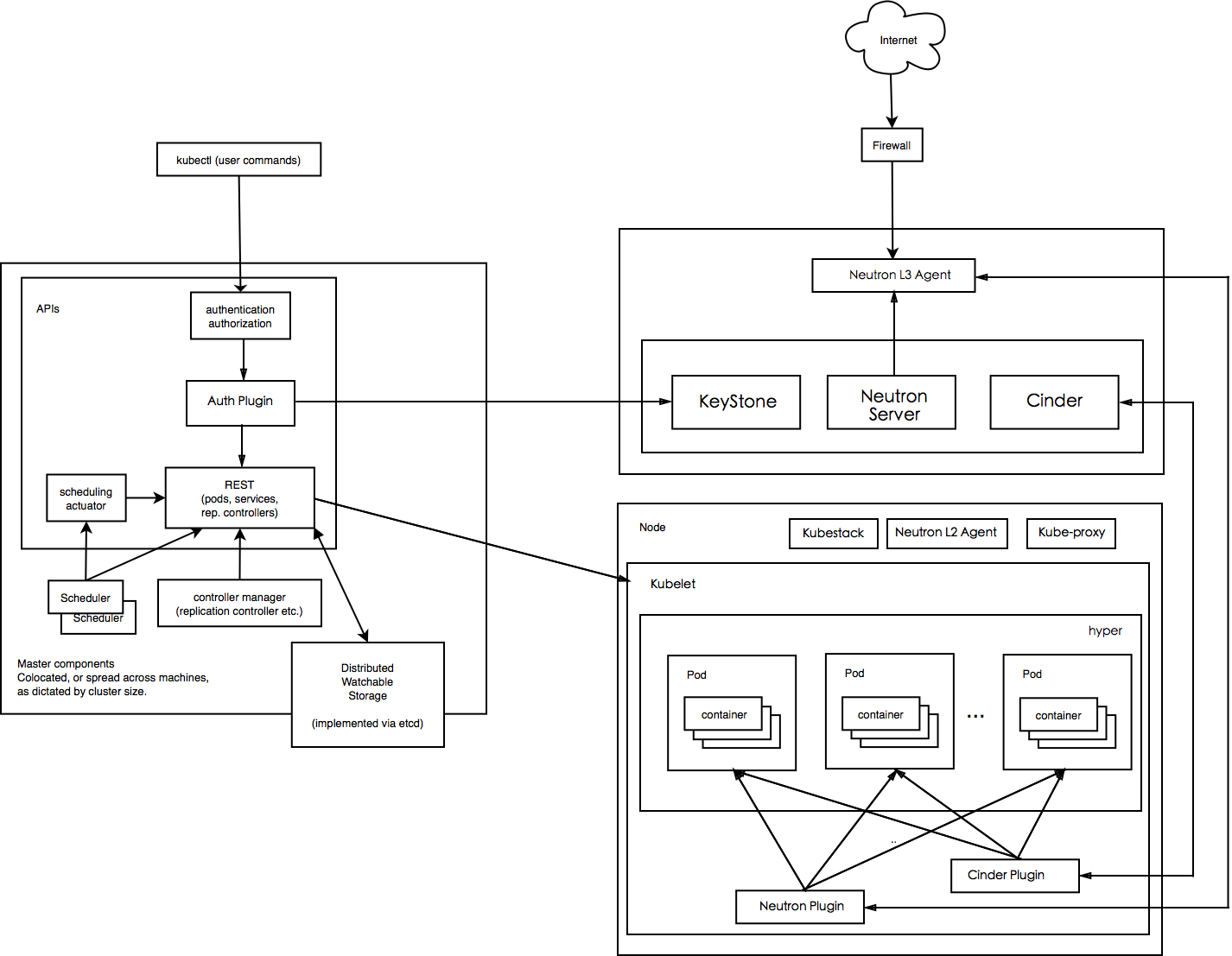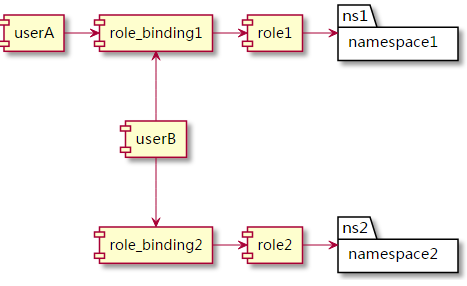本文介绍Hypernetes与Kubernetes之间的关系

Hypernetes相关链接
- Hypernetes的卖点
- github地址
- 基于 HyperContainer 和 Hypernetes 项目的公有云:Hyper_
- 知乎话题:如何评价 hyper_
- Secure NFV (Clearwater) deployment on Kubernetes (Hypernetes) in 10 min
- 项目拥有者博客
- 将Hypernetes整合至Kubernetes带来安全性与多租户机制
- Hypernetes安装日志
Hypernetes简介
Hypernetes在Kubernetes基础上增加了多租户认证授权、容器SDN网络、基于Hyper的容器执行引擎以及基于Cinder的持久化存储等。
基本上Hypernetes = Bare-metal + Hyper + Kubernetes + Cinder(Ceph) + Neutron + Keystone
在介绍Hypernetes细节之前先首先提一下相关背景,也就是Kubernetes的多租户支持情况。
Kubernetes在多租户方面的支持还是比较少的,没有“租户”这一概念,也只有namespace提供了一个逻辑的资源池(可以给这个namespace设定一些资源的配额),并且它在认证授权、网络、Container Runtime等方面离真正的多租户还都比较远。
认证方面,虽然支持client certificates,tokens,http basic auth等,但没有用户管理的功能。如果想要新建用户,需要手动修改配置文件并重启服务。最新版本增加了Keystone的认证,可以借助Keystone来管理用户。
授权方面,目前只有AlwaysDeny ,AlwaysAllow以及ABAC模式。ABAC模式根据一个策略文件来配置不同用户的权限,比如限定用户只能访问特定的namespace等,但对于新创建的namespace等资源需要重复修改策略文件。
Kubernetes要求cluster内部所有的容器之间是全通的,而多租户情况下需要不同租户之前网络是隔离的。
Docker的安全性问题,跟虚拟化还是有不少距离。
正是由于上面这些原因,很多公司都在虚拟机里面来跑Kubernetes,比如Google Container Engine、OpenStack Magnum等。
在虚拟机内部跑容器虽然提升了安全性,但也引入了一些问题,比如容器的网络不能通过IaaS层来统一管理,容器无法直接使用IaaS层的持久化存储,无法集中调度所有容器的资源等。
先来看一下Hypernetes的架构图

Hypernetes在Kubernetes基础上增加了一些组件
增加了Tenant的概念,不同Tenant之间的网络和资源(ns, pod, svc, rc等)是隔离的。这些租户通过keystone管理,并提供认证和授权
通过Neutron给不同租户提供二层隔离的网络,并支持Neutron的各种插件(目前主要是ovs)
通过Hyper提供基于虚拟化的容器执行引擎,保证容器的隔离
还有通过Cinder给容器引入各种持久化存储(目前主要是ceph)
具体到Hypernetes内部,详细的架构是这样的

为了支持多租户,Hypernetes基于Kubernetes增加了很多组件,这些组件都是以Plugin的形式提供的。
这样非常方便扩展,也很容易将Hypernetes与现有的IaaS在同一个基础架构上运行起来
比如,如果你不喜欢Neutron,可以把它替换成odl等。
与Kubernetes的关系
The hypervisor-based container runtime for Kubernetes,通过Hyper提供基于虚拟化的容器执行引擎,保证容器的隔离,并将其贡献在kubernetes组织下:frakti,再通过CRI(Container Runtime Interface),原生接入Kubernetes,类似CoreOS公司的rkt接入kubernetes。 在Hypernetes v1.6版本中,Hypernetes的容器运行时也将从一套名为runV的OCI标准容器运行时切换到frakti。
Hypernetes 是从Kubernetes项目中fork出来的。为了支持多租户,Hypernetes基于Kubernetes增加了很多组件,这些组件都是以Plugin的形式提供的。
关于虚拟化和容器化的思考,可以参见项目拥有者的一篇报告Re-Think of Virtualization and Containerization
Hypernetes 借助Kubernetes中的RBAC(Role-Based Access Control)来实现接入控制,具体方式如下图所示

userA和userB是通过[role_binding1][role1]连接到name space 1,得到在name space1进行操作的权限。userB则是[role_binding2]->[role2]得到在name space2进行操作的权限。
Proposal of hypernetes1.6 auth
Continue to use keystone, Keystone authentication is enabled by passing the –experimental-keystone-url=
option to the API server during startup Use RBAC for authorization,enable the authorization module with –authorization-mode=RBAC
Add auth-controller to manage RBAC policy
auth workflow:
kubectl apiserver keystone rbac auth+controller
+ + + + +
| 1 | | | |
+-----+request+---------> | | |
| | 2 | <--+update policy++
| +----+Authentication+-----> | |
| | 3 | | |
| <---+user.info,success+---+ | |
| | 4 + | |
| +-------------------+Authorization+------------> |
| | 5 + | |
| <--------------------+success+-----------------+ |
| 6 | + | |
<-----+response+--------+ | | |
| | | | |
+ + + + +
To update rbac policy, auth-controller need to get user-info. Auth-controller update
ClusterRoleandRoleBindingto get permissions of namespaces, when user is updated. May be we should add user as a kind of resource.Watch
Namespaceand update the permissions of namespace scoped resources for regular user.
- kubectl send request with (username, password) to apiserver
- Apiserver receive request from kubectl, and call AuthenticatePassword(username, password) to check (username, password) via keystone.
- If check successfully return (user.info, true), continue to step4. if check fail return (user.info, fales), request fail.
- call Authorize(authorizer.Attributes) to check RBAC roles and binding.
- if check success return true and execute operation of the request. if check fail return false ,request fail.
- return request result
Add user
- Use Third Party Resources to create user resource :
apiVersion: extensions/v1beta1
kind: ThirdPartyResource
metadata:
name: user.stable.example.com
description: "A specification of a User"
versions:
- name: v1
- Add a user object. May be there more detail user information will be set using custom fields like
username. At least username are required.
apiVersion: "stable.example.com/v1"
kind: User
metadata:
name: alice
username: "alice chen"
auth-controller
auth-controller is responsible of updating RBAC roles and binding when
- new user is created: allow the user to create/get namespace
- new namespace is created/deleted
- network is created/deleted
- user is removed: delete all user related data
auth -controller will watch resources including User, NameSpace, Network and update RBAC roles and binding using superuser. First create ClusterRole for regular user to get permissions of NameSpace:
kind: ClusterRole
apiVersion: rbac.authorization.k8s.io/v1alpha1
metadata:
# "namespace" omitted since ClusterRoles are not namespaced.
name: namespace-creater
rules:
- apiGroups: [""]
resources: ["namespace"]
verbs: ["get", "create"] # I think verbs should include "delete",user have permission of deleting their namespace
new user are created:
create ClusterRoleBinding for new regular user reference namespace-creater role:
kind: ClusterRoleBinding
apiVersion: rbac.authorization.k8s.io/v1alpha1
metadata:
name: username-namespace-creater
subjects:
- kind: User
name: username
roleRef:
kind: ClusterRole
name: namespace-creater
apiGroup: rbac.authorization.k8s.io
a new namespace are created:
create Role namespaced:
kind: Role
apiVersion: rbac.authorization.k8s.io/v1alpha1
metadata:
namespace: namespace
name: access-resources-within-namespace
rules:
- apiGroups: [""]
resources: [ResourceAll]
verbs: [VerbAll]
create Rolebinding reference to role namespace:
kind: RoleBinding
apiVersion: rbac.authorization.k8s.io/v1alpha1
metadata:
name: namespace-binding
namespace: namespace
subjects:
- kind: User
name: username
roleRef:
kind: Role
name: access-resources-within-namespace
apiGroup: rbac.authorization.k8s.io
role and rolebinding will be removed when namespace are deleted
a network is created/deleted
Network will be defined non-namespaced resource. we can set permission of Network in ClusterRole when user are created.
a user is deleted:
ClusterRoleBinding related the user will be removed at least.
文档信息
- 本文作者:Yu Peng
- 本文链接:https://www.y2p.cc/2017/06/05/hypernetes-and-kubernetes/
- 版权声明:自由转载-非商用-非衍生-保持署名(创意共享3.0许可证)